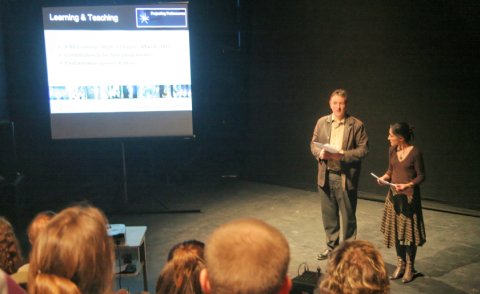
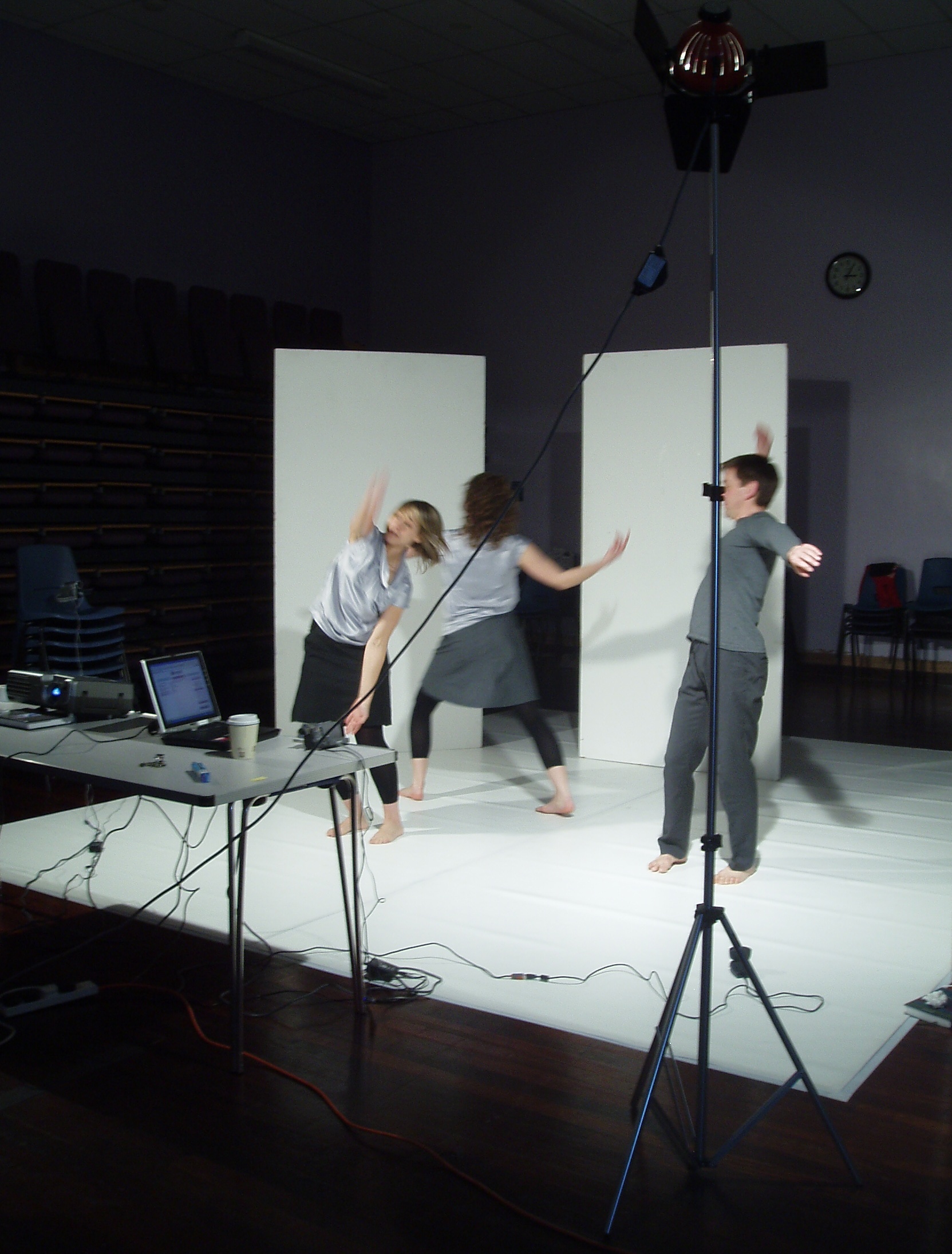
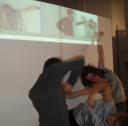
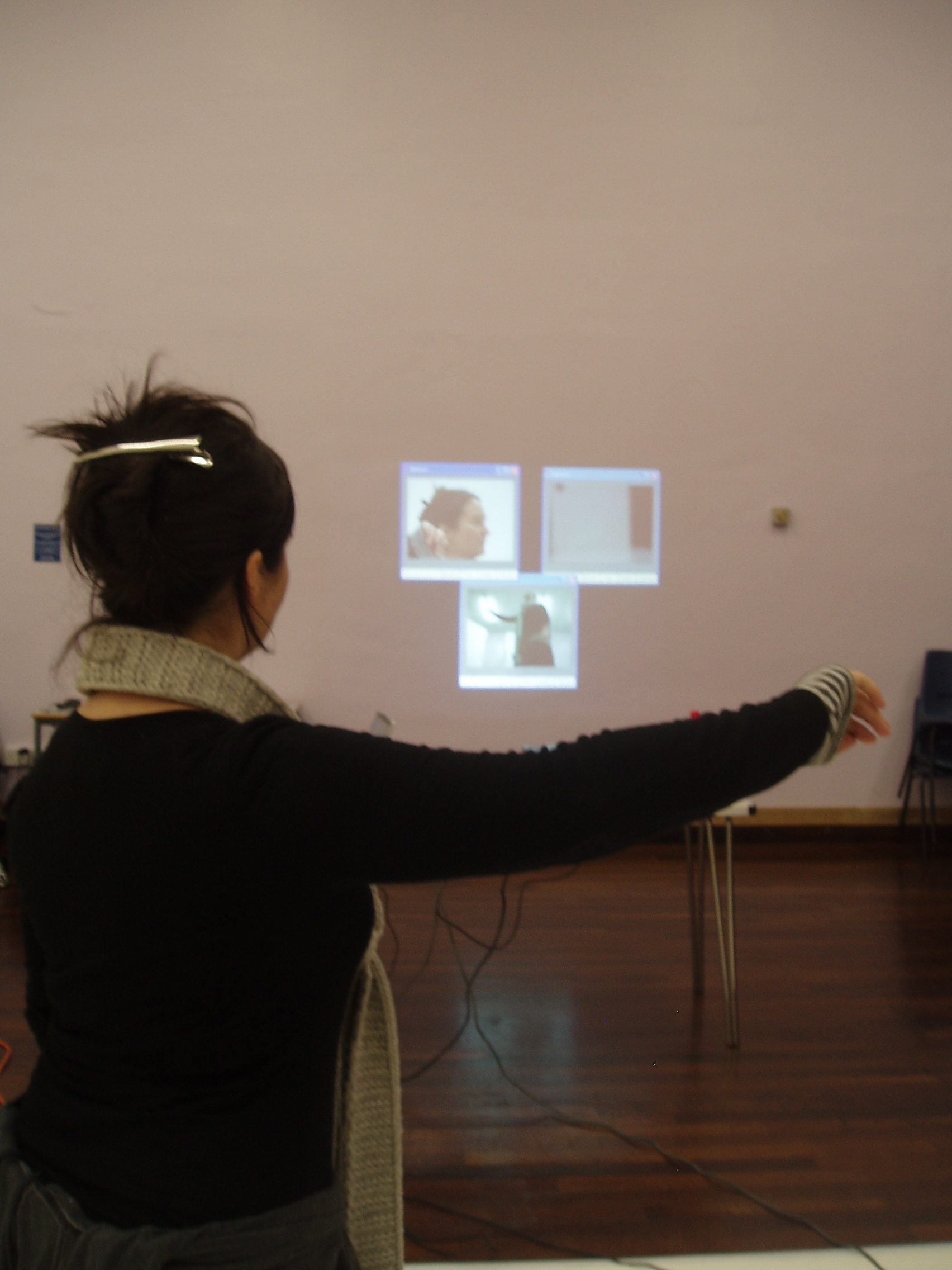
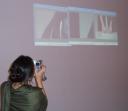
 Between 7th and 9th January 2008, Helen and Sita are working intensively in the dance studio in Bedford to explore the performative possibilities of Access Grid and to develop some initial material for review. On 7th Jan, Anja Le Blanc came down from Manchester to help us set up, bringing a self-contained kit developed by Andrew Rowley that simulates an Access Grid node. Multiple video streams will then be uploaded in Manchester for future reference. After half a day of trial and error, we finally got it all working! Yesterday was very productive. We worked with three dancers: Nicola Drew, Amalia Garcia, and James Hewison.
Between 7th and 9th January 2008, Helen and Sita are working intensively in the dance studio in Bedford to explore the performative possibilities of Access Grid and to develop some initial material for review. On 7th Jan, Anja Le Blanc came down from Manchester to help us set up, bringing a self-contained kit developed by Andrew Rowley that simulates an Access Grid node. Multiple video streams will then be uploaded in Manchester for future reference. After half a day of trial and error, we finally got it all working! Yesterday was very productive. We worked with three dancers: Nicola Drew, Amalia Garcia, and James Hewison.
We thought initially that we would primarily be concerned with creating mediated material for future use, but actually we found that because of the system’s interactive capacity we had to create material between the live and the mediated in order for the improvisations to have a logic that supported that capacity. All of our dancers were co-located at this point, but we were considering the ramifications of non-co-locatedness for future workshops.
To begin with, we were interested in the framing potential of the multiple cameras, and we played with perspective and scale through a series of improvisations using pre-existing movement material. Key ideas for this workshop are:
– Formal composition of the frame
– The interrelationships between multiple frames
– Social formulations of space
– Notions of presence and absence in performance.
In relation to formal composition, we are concerned with individual ‘frame’ or ‘window’ as a self-contained video entity. Multiple frames or windows arranged together enable porous spaces that the dancers can move between literally (see images on this blog). Multiple frames provide further compositional complexity as you are composing between them (dancers can literally move across the windows) but you are also composing the arrangement of the windows and their motion as further choreographable components. Currently all of our dancers are co-located, allowing movement across all of the windows. This allows for located spatial continuity in the choreography. However we will be exploring implications of fracturing that continuity through non-co-locatedness whilst maintaining the ‘liveness’ of performance.Â
The concept of social space and social formulations of space was highlighted through an early improvisation. Two dancers worked solely through mediated images in a telematic sense, negotiating their activity visually, motionally, and verbally – verbal language added a further level of complexity, highlighting performer subjectivity. The ‘window’ took precedence over the frame, engaging with documentary/filmic aesthetic constructs and visual grammar (e.g. eye contact, head shots, talking to camera). This highlighted socio-political concerns around power, and the ideas of space and the visual working together in terms of the negotiation and distribution of power. (Interestingly, Nicola’s role within the improvisation was to respond directly to a camera without having a window relay of either herself or Amalia. Her only feedback was auditory rather than visual. This lack of the visual sense had a direct impact on her power relation, leading to questioning of the hierarchical relationship between the visual and the embodied for the dancers. The visual overrode linguistic and motional communication in terms of the distribution of power. We discovered that whoever had visual feedback became dominant within this mediated environment. Very quickly this improvisation began to have its locus in ideas of presence and absence, in terms of the subject, meaning, and modes of communication. Overlaid onto the improvisation as a further level of complexity as the task developed was the premise of failure to communicate through any one of those channels, thus highlighting liveness.
We discovered that in the improvisations focusing on social space, the ‘windows’ have a Brechtian function that draws attention to liveness, as they reference the computer context and frame the space and its social interrelationships. This connects to concepts surrounding social networking and similar technologies that are becoming increasingly embedded in mainstream communications. It draws upon notions of social etiquette emerging in these online contexts and provides an interesting route for this research.
In the improvisations that were more concerned with formal composition of choreography and film, the windows became a real hindrance because we were working with a sense of continuity and we didn’t necessarily want to highlight the constructedness of the ‘frame’ in the philosophical/literal sense. This highlighted for us the fundamental differences between the frame and the window – in the formal context we want to work with the ‘frame’, and in the social context we are happy to work with the ‘window’. (See project references for Bolter & Gromala’s ‘Windows and Mirrors’ and Friedberg’s ‘The Virtual Window’.)
Helen and Sita will be revisiting the documentation and video streams from this workshop in Manchester at the end of January 2008. We hope that this will provide a useful starting point for the software developers to begin to think about how the Access Grid can be designed to be more attuned to the requirements of performance and creative practice. This will have clear implications/applications beyond the arts for social practices in networked communications.

